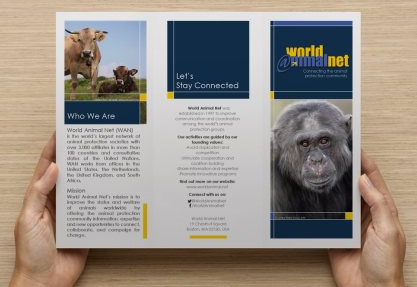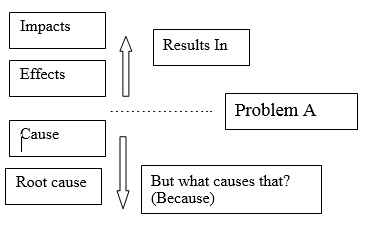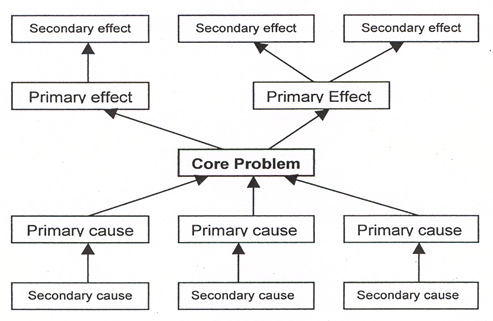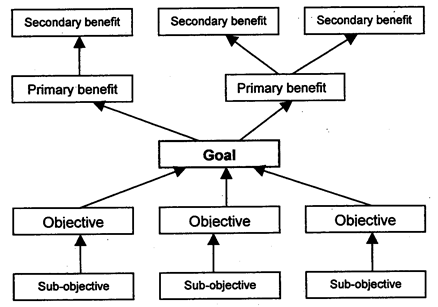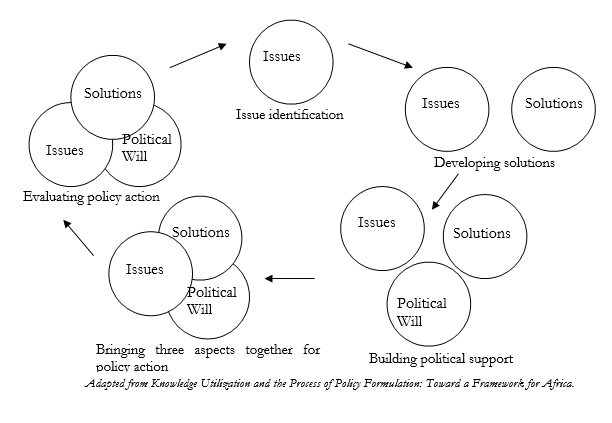
Download Our New Brochure!

World Animal Net has a brand new brochure! Download to read more about our work and programs.
Download the PDF
2. Causal Mapping or Problem Tree Analysis

Category:
A primary tool (either this or a fishbone diagram)
Description and Purpose:
This is a visual mapping tool for synthesizing and visualizing the results of research and analysis on a specific issue. It helps to dissect a problem, to establish root causes (which aids the design of effective and targeted interventions) and effects.
Method:
This visual mapping tool is similar to a Fishbone Diagram (see note below). It is useful after problem identification to place issues in their wider context, and clarify that the issue under question is the real problem, not a symptom of a different problem.
This tool is ideally suited to group work – with colleagues, partner organizations, or a coalition. A facilitator can aid the group. To start the diagram or tree, generate the causes and effects on Post-it notes and stick them onto a large piece of paper.
Ask ‘but why’ or ‘what causes that?’ at each stage when seeking root cause.
Ask ‘what happened’ or ‘what does that lead to’ at each stage when seeking final impact.
It is effective when done using ‘post it’ slips, as these can be moved around as the process unfolds e.g. when causes are later identified as root causes.
Diagrammatically, the mapping can unfold as follows:
This can also be designed as a problem tree. The tree has a trunk that represents the core problem, roots that represent the causes of the problem, and branches that represent the effects.
In considering problem causes, do not forget to include the policy environment and whether new policies are necessary or whether existing policies are being implemented effectively.
Next, the effects of the problem are drawn (as branches of the tree). Once again, the diagram should identify links between issues by joining branches together. Find out what people know about each root cause and each effect of the problem. Details and reasons may reveal further causes and effects.
The group can then negotiate the relationships between the cards and how they should be placed. The diagram or tree can be re-framed by making one of the causes or effects as the core problem, and re-adjusting the other cards around it. You may want to do this to refocus your issue to one that you can better influence.
You can then use the diagram or problem tree to produce a solution tree, where the trunk is your main aim, the roots are objectives and the branches are the benefits that will arise from your aim being met.
You reverse the core problem to create a goal (or aim) (cover the card with a new one with the goal written on it). Similarly you convert the effects to benefits, and causes to objectives – simply by reversing the language used.
At this stage, you should not leap ahead into how the objectives might be achieved. For example, if one of the ‘causes’ was ‘lack of understanding’, your ‘objective’ should be ‘increased understanding’, not to institute an education program – there may be other methods of achieving the objective that you will want to consider at a later stage in the planning process.
The objectives do not all have to be advocacy objectives. They can also be objectives that are best met through other types of animal welfare work. Using this technique can enable you to devise an integrated strategy of projects and advocacy, both being part of your wider program. The advocacy objectives will not necessarily fall in the first line next to the goal – these may be quite broad and the most focused objective needed for advocacy may be on the second row.
In the course of doing the problem and solution trees, you may realize that there are gaps in your knowledge that need further research. That is fine, and is another benefit of using a tool such as this for your analysis.
The effects and benefits you produce are important, as they are going to form the basis of your compelling argument that brings you more support and eventually persuades the policy maker to change their position.
The objectives you arrive at are important because they may provide a basis for your project or wider program.
1. Issue Choice Matrix

Category:
A primary tool (but feel free to adapt content to suit your purposes)
Description and Purpose:
This is a tool for analyzing the best choice of advocacy issue. It works by rating each issue against given criteria.
Method:
Apply a rating to each issue for each criterion – using a positive ranking of 1-5 (with 5 being the maximum).
Adapt according to your organization’s priorities and needs (e.g. add fundraising potential; media potential etc.). Consider changing rankings to reflect major priorities (e.g. give double point to likelihood of success, potential benefits and potential for your organization to make an impact).
| Criteria | Policy Issue 1 | Policy issue 2 | Policy issue 3 |
| Likelihood of success | |||
| Potential benefits for animal welfare |
|||
| Potential for you to make a difference (or is the bus overcrowded?) |
|||
| Relevance to your work and objectives? |
|||
| Potential for networking and coalitions (i.e. relationship with the relevant allies is strong) |
|||
| Possibility to use the advocacy for capacity- building |
|||
| The issue is something you care passionately about (this is important as it will motivate you to take action on the issue? |
|||
| TOTAL |
This can be amended according to your own criteria (and perceived level of importance). As with all tools, it is simply for guidance, and should be adapted where necessary to achieve the most relevant results for your organization. For example, although it is generally accepted that you should try to make the most difference to the welfare of animals through your choice, if this is your first advocacy initiative you may want to start with a small, limited-time advocacy issue – to build aptitude and confidence.
The Issue

Selecting a Policy Issue
Problem Causes and Impacts
Issue Solutions
Selecting a Policy Issue
There are many ways in which an advocacy issue can be selected reactively, including:
- You keep being faced with a particular animal welfare problem, which the authorities fail to resolve
- You face particular barriers to your animal welfare work which you feel could be overcome through targeted advocacy
- Animal welfare activities that you are involved with may have resulted in successes that could be replicated more widely. Advocacy may help in sharing that experience and ‘scaling up’ the impact of the work
- Institutions and organizations whose policies and practices affect the welfare of animals may announce new proposals or start new activities that need to be responded to – either by resisting or modifying these proposals or activities
- Opportunities for other changes may arise – perhaps because an issue becomes more widely discussed in the media, or because an international conference on that issue is scheduled.
A proactive approach can also be taken to the development of advocacy issues. This will usually be initiated by research and analysis. This could be decided on during strategic planning for your organization, or as part of a review of its existing programs on certain issues. Both of these should include the identification of major development trends, and research and analysis of the policy environment to ascertain whether policies and implementation are successfully meeting animal welfare needs. When an advocacy issue is identified in this way, it can be meaningfully integrated into program work, and strategically used as a tool to achieve program objectives.
The number of advocacy issues it is possible to tackle will depend on your organizational and personal resources. It is generally advisable to focus your work on only as many objectives as you can realistically achieve (which may be just one for smaller organizations). Advocates who attempt to fix everything run the risk of changing nothing in the process.
This means that advocacy issues need to be chosen carefully. However the advocacy issue arises, it is recommended that any decisions on the most appropriate advocacy initiatives are preceded by full research and analysis. Without this overview, it is impossible to determine which advocacy approach is likely to lead to the most effective outcome for the issue (in terms of sustainable change).
|
Advocacy Tool Tool 1. The Issue Choice Matrix |
In making your choice of advocacy issue, do not forget that:
- The issue must be of relevance to your organizations broader strategy.
- The issue should be something you care passionately about and want to advocate on (as this will motivate your work).
- You need to carry out a risk analysis to ensure that your choice of issue will not bring harm to your organization (or that the envisaged benefits far outweigh any risk of harm).
Problem Causes and Impacts
Once you have identified your main issue you need to identify the causes and impacts of the problem.
|
Advocacy Tool Tool 2. Causal Mapping or Problem Tree Analysis |
|
Caution! Whilst the problem tree can be a useful tool it also has negative connotations, because it focuses on problems, rather than looking at solutions. You may wish to also use idea-generating approaches. ‘Appreciative Inquiry’ methods, examine past successes and achievements, with a view to replicating or improving on these. Combine with other tools to generate new and creative ideas. |
Issue Solutions
The process of developing and implementing advocacy solution for your issue can be seen in the following diagram:
In brief, this works as follows:
- Begin by identifying your issue (see above)
- Carry out extensive research and analysis on your issue to develop clear and practical solutions, including problem analysis and stakeholder analysis.
- Work to build political support for your policy change solutions
- Use political support to push through solutions
- Evaluate the policy action taken, and identify new or unresolved issues.
Once you have mapped out the problems, by using the problem tree, you will want to make sure your report ‘comes alive’ for the reader. Your research report should include case studies relevant to your issue and target audience.
|
Advocacy Tool Tool 3. Research Case Studies |
Module 3
Opportunities at World Animal Net

World Animal Net currently has the following openings:
Database Maintenance Volunteer (Ongoing)
Help animals around the world by volunteering for them from Boston! World Animal Net seeks volunteers to assist in the maintenance of the World Animal Net Directory, which contains the name, address, website, email, and social media information of over 17,000 animal protection organizations around the world. The goal of the directory is to facilitate communication and collaboration between the world's animal protection groups.
Responsibilities:
- Verify existing listings
- Make updates to listings where needed
- Identify and add new animal protection groups to the directory
- Communicate with animal protection organizations as needed to retrieve necessary information for database
Qualifications
- Basic computer skills
- Basic knowledge of Internet search engine use
- Basic communication skills
- An interest in database management and maintenance and/or improving the status and welfare of animals
Time Commitment and Location
- 5+ hours per week, 10+ hours per week preferred
- Would require some in-office hours initially for training, but could shift to work from home if that is preferred by the volunteer
- The World Animal Net Boston office is easily accessible from all subway lines (Green and Red from Park St. Station and Orange and Blue from State St. Station)
If interested please contact us at info@worldanimal.net
External Link
External Link
Welcome to Our Brand New Website!

Take the Tour
Directory
Our Directory provides contact information, and, where applicable, email, website and social media links for over 17,000 animal protection organizations. You can search this directory by organization name, area of focus, or location.
Don't see your organization listed or find information that is outdated? Help us maintain the quality of our Directory by Registering Your Organization, logging in to update your listing (using the button on the right of the footer), or Contacting Us with any other updates.
Events
The Events calendar is a new and expanding section of the website where we list past and upcoming animal protection events, from film premiers and festivals to professional or academic conferences happening around the world.
Does your organization have an upcoming event you would like to see listed? Let us know by Registering an Event. We will be happy to help you publicize your event on our calendar!
Resources
Our Resources section is divided into nine different topics, including Animal Protection Law, Society Management, and overviews of various Animal Welfare Issues. You can start exploring these resources from our new and improved Resources Index which gives a brief description of each topic.
Jobs and Volunteering
Our Jobs and Volunteering pages have long been a popular destination for those seeking employment, volunteer, or intern opportunities in animal protection.
About Us
Finally, our About Us section will tell you a little bit more about WAN, our history, mission, and who works behind the scenes to provide these resources free of charge!
Responsive Design
Our new website is now also compatible with smart phones, tablets and other handheld devices, so you can take us with you wherever you need to go!
Keep in Touch
Let us know what you think about the new site! We would love to hear from you. You can also find us on Facebook or Twitter, where you can stay updated about animal protection issues, upcoming events, and WAN's work.
We look forward to seeing you there.
Best,
Volunteering with WAN

Who can volunteer?
Most of our volunteers work remotely, which means that anyone in the world with access to a computer and the internet and a passion for animal protection can help us in our mission to support and enhance the animal protection movement.
How to volunteer?
To apply to be a World Animal Net volunteer simply fill out our volunteer application and submit it electronically to info@worldanimal.net or, alternatively, contact us through one of our listings on VolunteerMatch. If your skills and interests are a good fit for one of our open positions, our staff will be in contact to schedule a quick meeting by phone, Skype or (if applicable) in person.
What do volunteers do?
Most of our volunteers help us in maintaining the World Animal Net Directory of Animal Protection Organizations. Our volunteers assist us in correcting broken links, verifying contact information, and adding new organizations to the directory. Some volunteers focus on data entry only, while others focus on updating listings of specific geographic locations while highlighting any particularly innovative or effective campaigns. Past volunteers have updated our listings in Vietnam, the Middle East, Canada, and Austria.
Other volunteers help us expand our resources on fundraising. WAN’s fundraising resources are intended to help animal protection organizations in their own fundraising efforts. Fundraising research volunteers compile details about funders that may support the animal protection work of World Animal Net and other groups, including key deadlines, principal areas of geographic and issue focus, and proposal guidelines.
You can read about our current volunteer openings below:
Data Entry Volunteer
Regional Research Volunteer
Fundraising Research Volunteer

